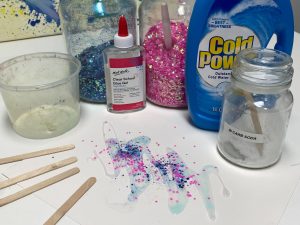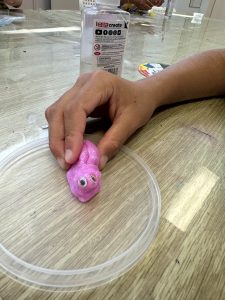At Artlis Studios, we love blending art and science in our classes, especially for our homeschool students. This week, our class took on a fun and messy challenge: creating “Melting Monsters” using non-Newtonian fluids (Slime)!
The homeschool kids were introduced to the fascinating world of kinetic sculptures. Kinetic art refers to any art that moves or changes form over time, and what better way to illustrate this than by creating creatures that slowly melt before your eyes?
The Art-Science Connection
Science and art may seem like two different worlds, but they are often closely linked. When you think about it, both disciplines are about experimentation. In science, you form a hypothesis, test it, and observe the results. Similarly, in art, you explore ideas and techniques, experimenting to see how your creative vision comes to life. This connection between the two was front and center in our class.
We kicked off by explaining what a non-Newtonian fluid is—matter that doesn’t fit neatly into the traditional categories of solid, liquid, or gas. The children were fascinated by how their creations could behave like a solid when force was applied, yet melt away into a liquid form once the force was removed. It was a perfect way to introduce them to kinetic art and give them a hands-on lesson in science!
Creating the Melting Monsters
Our “Melting Monsters” class was a huge hit! First, the kids made a special type of slime—our version of a non-Newtonian fluid. We often teach kids about long-chain polymers when we make slime, introducing them to how different substances react when combined. Once the slime was firm enough, the students sculpted their creatures, adding googly eyes and other fun decorations to bring their monsters to life.
But the real magic happened next. Over the course of 5 to 15 minutes, the kids got to watch their creations melt into colorful puddles. It was an exciting and tangible way for them to see the effects of applying and releasing force on their sculptures.
The Recipe for Fun and Learning
If you’d like to try this project at home or in a classroom setting, here’s the recipe we used for our non-Newtonian slime.
The activator in this slime is Cold Power liquid laundry detergent. We have tried many different types of laundry liquid and alas, they are not all made the same! Make sure you do a test with your liquid before introducing it to a full class of kids!

Ingredients:
- 1/4 cup of clear washable school glue
- 2-5 tablespoons of washing detergent (make sure you test it, as some don’t work!)
- a tiny pinch of bicarb soda (this is vitally important to make the activator work properly)
You can also add glitter, food dye, and googly eyes to the collection if you wish.
Instructions:
- Adding a drop of food colouring and a spoon of glitter to your glue and stirring it before you start mixing in the activator can make for a less messy experiment, but if you don’t care about stained fingers, then you can add the food colouring and glitter at the end.
- Mix the pinch of bicarb into the glue. (make sure it is a very small amount, the more bicarb you have, the firmer the slime will be.)
- Mix in 1 tablespoon of laundry liquid at a time, testing the stickiness after each mix in. It does take a few minutes for the chemical reaction to set in properly, so we get the kids to mix fiercely for at least a minute.
- If all 5 spoons of the laundry liquid is mixed in and it’s till too sticky, a tiny dust of bicarb soda can fix it! Remember the slime gets firmer with more bicarb.
- Have your kids mold their monsters onto a shiny surface such as a stiff plastic tablecloth, add googly eyes and and watch them slowly melt as the slime changes form.
This activity not only sparks creativity but also serves as a mini-lesson in the science of matter. You can discuss long-chain polymers, the states of matter, and even dive into chemical reactions. It’s a wonderful way to make learning interactive and memorable.
At Artlis Studios, we believe that projects like this show just how much art and science go hand in hand. Every experiment is an opportunity for children to learn about the world around them, express their creativity, and gain confidence in their ability to make something uniquely their own.
If you’re looking for ways to engage your kids in both art and science, give us a call on 0400 382 617 to book your homeschool group! There’s always a new experiment just around the corner. 

